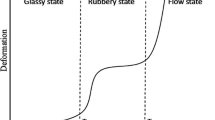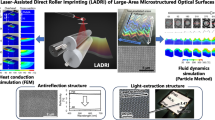Abstract
A thin and uniform residual layer, especially zero-residual layer, is highly desired in the nanoimprint lithography, because it is critical to the succeeding pattern transfer process. In this study, a partial cavity filling method was applied on UV-curable resins instead of thermal plastic polymer to realize zero-residual layer based on a hybrid nanoimprint technique. The initial thickness of the UV-curable resin on the substrate was precisely quantified less than the cavity volume of the imprint mold by adjusting the resin concentration and spin coating speed. A near-zero-residual layer was successfully achieved under an extremely low imprint pressure by the control of the viscosity, surface tension and thickness of the UV-curable resist.





Similar content being viewed by others
References
S.Y. Chou, P.R. Krauss, P.J. Renstrom, Imprint of sub-25 nm vias and trenches in polymers. Appl. Phys. Lett. 67, 3114–3116 (1995)
S.Y. Chou, P.R. Krauss, P.J. Renstrom, Nanoimprint lithography. J. Vac. Sci. Technol. B 14, 4129–4133 (1996)
H. Hiroshima, H. Atobe, Homogeneity of residual layer thickness in UV nanoimprint lithography. Jpn. J. Appl. Phys. 48, 06FH18 (2009)
H. Lee, G.-Y. Jung, Full wafer scale near zero residual nano-imprinting lithography using UV curable monomer solution. Microelectron. Eng. 77, 42–47 (2005)
J.-H. Kang, K.-S. Kim, K.-W. Kim, Molecular dynamics study on the effects of stamp shape, adhesive energy, and temperature on the nanoimprint lithography process. Appl. Surf. Sci. 257, 1562–1572 (2010)
H. Lee, G.-Y. Jung, UV curing nanoimprint lithography for uniform layers and minimized residual layers. Jpn. J. Appl. Phys. 43(12), 8369–8373 (2004)
H.-J. Lee, H.W. Ro, C.L. Soles, R.L. Jones, E.K. Lin, W.-L. Wu, Effect of initial resist thickness on residual layer thickness of nanoimprinted structures. J. Vac. Sci. Technol. B 23(6), 3023–3027 (2005)
H. Lee, Effect of imprinting pressure on residual layer thickness in ultraviolet nanoimprint lithography. J. Vac. Sci. Technol. B 23(3), 1102–1106 (2005)
N. Bogdanski, M. Wissen, A. Ziegler, H.-C. Scheer, Temperature-reduced nanoimprint lithography for thin and uniform residual layers. Microelectron. Eng. 78–79, 598–604 (2005)
Jarrett Dumond and Hong Yee Low, Residual layer self-removal in imprint lithography. Adv. Mater. 20, 1291–1297 (2008)
K.-Y. Yang, K.-M. Yoon, J.-W. Kim, J.-H. Lee, H. Lee, Low temperature fabrication of residue-free polymer patterns on flexible polymer substrate. Jpn. J. Appl. Phys. 48, 095003 (2009)
Z. Li, Y. Gu, L. Wang, H. Ge, W. Wu, Q. Xia, C. Yuan, Y. Chen, B. Cui, R.S. Williams, Hybrid nanoimprint soft lithography with sub-15 nm resolution. Nano Lett. 9(6), 2306–2310 (2009)
B. Li, J. Zhang, H. Ge, A sandwiched flexible polymer mold for control of particle-induced defects in nanoimprint lithography. Appl. Phys. A 110, 123–128 (2013)
M. Colburn, Proc. SPIE 3676, 379–389 (1999)
M.D. Austin, H. Ge, W. Wu, M. Li, Z. Yu, D. Wasserman, S.A. Lyon, S.Y. Chou, Fabrication of 5 nm linewidth and 14 nm pitch features by nanoimprint lithography. Appl. Phys. Lett. 84, 5299–5301 (2004)
Acknowledgments
This work was jointly supported by the National Basic Research Program of China (973 Program) (Grant No. 2013cb632702), the National Nature Science Foundation of China (Grant No. 51473076) and the Priority Academic Program Development of Jiangsu Higher Education Institutions and RFDP.
Author information
Authors and Affiliations
Corresponding author
Rights and permissions
About this article
Cite this article
Cui, Y., Lu, J., Fu, X. et al. Near-zero-residual layer nanoimprint based on hybrid nanoimprint soft lithography. Appl. Phys. A 121, 371–375 (2015). https://doi.org/10.1007/s00339-015-9195-z
Received:
Accepted:
Published:
Issue Date:
DOI: https://doi.org/10.1007/s00339-015-9195-z




